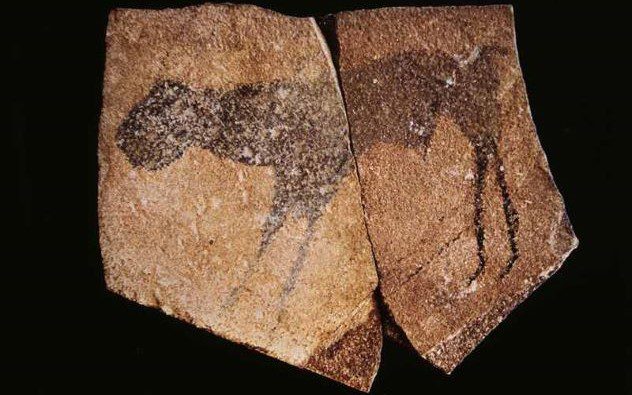 Mysteries
Mysteries  Mysteries
Mysteries  History
History 10 Surprising Stories About the Texas Rangers
 Humans
Humans 10 Philosophers Who Were Driven Mad by Their Own Theories
 Miscellaneous
Miscellaneous 10 Video-Game-Worthy Weapons and Armors from History
 Weird Stuff
Weird Stuff 10 Psychics Who Accurately Predicted Wartime Events
 The Arts
The Arts 10 Pieces of Art Inspired by a Broken Heart
 Health
Health 10 Science Fiction-Sounding New Medical Treatments
 History
History 10 Surprising Facts About the Father of Submarine Warfare
 Space
Space Ten Astonishing New Insights into Alien Worlds
 Weird Stuff
Weird Stuff 10 Bizarre Summer Solstice Rituals Still Practiced Today
 Mysteries
Mysteries Top 10 Haunting Facts About the Ghost Ship MV Alta
 History
History 10 Surprising Stories About the Texas Rangers
 Humans
Humans 10 Philosophers Who Were Driven Mad by Their Own Theories
Who's Behind Listverse?

Jamie Frater
Head Editor
Jamie founded Listverse due to an insatiable desire to share fascinating, obscure, and bizarre facts. He has been a guest speaker on numerous national radio and television stations and is a five time published author.
More About Us Miscellaneous
Miscellaneous 10 Video-Game-Worthy Weapons and Armors from History
 Weird Stuff
Weird Stuff 10 Psychics Who Accurately Predicted Wartime Events
 The Arts
The Arts 10 Pieces of Art Inspired by a Broken Heart
 Health
Health 10 Science Fiction-Sounding New Medical Treatments
 History
History 10 Surprising Facts About the Father of Submarine Warfare
 Space
Space Ten Astonishing New Insights into Alien Worlds
 Weird Stuff
Weird Stuff 10 Bizarre Summer Solstice Rituals Still Practiced Today
Ten Oldest Known Cave Paintings in the World
The caves of the world contain some of the best ancient works of art ever created. Not all of them may be as spectacular as those of Altamira in Spain, which notably triggered Picasso to say that anything “after Altamira is only decadence.” They all do, however, offer understanding into the way our ancient ancestors thought, even though the works of art were created tens of thousands of years ago.
Worldwide, these ancient artworks also continue to be of particular significance to indigenous communities, who see them as an integral part of their spiritual and cultural heritage. It has also emerged as an essential source of cultural tourism and constitutes a crucial economic revenue in several countries around the globe. As we’ve looked at the oldest sculptures in the World recently, we now turn our attention to a list of the oldest cave paintings in the world.
Related: 10 Fascinating Cave Finds That Will Blow Your Mind
10 Apollo 11 Cave—Namibia
(25,500–27,500 Years Old)

The Apollo 11 Cave lies about 160 miles (250 kilometers) southwest of the town of Keetmanshoop in southwestern Namibia. The surrounding region and, quite possibly, the cave was originally named “Goachanas” by the Nama people. However, the German archaeologist Wolfgang Erich Wendt was actively excavating inside the cave on July 24, 1969, when he learned of Apollo 11’s team’s safe return to Earth. He renamed the cave to celebrate the occasion.
The cave housed several of the oldest portable artworks in southern Africa, carbon-dated between 27,500 and 25,500 years old. The slabs of art discovered within the cave are commonly referred to as the Apollo 11 stones. In total, seven grey and brown quartzite slabs have been unearthed in the cave. Apart from the Apollo stones, the cave also contained numerous red and white paintings, which ranged from basic geometric shapes and patterns to images of bees, which can be a nuisance to unwary travelers to this day. Ancient artworks were also discovered in the form of engravings on the banks of a nearby river and on a massive limestone boulder a few feet from the cave’s entrance.[1]
9 Nawarla Gabarnmang—Australia
(28,000 Years Old)
In 2006, Ray Whear, the Jawoyn Association Aboriginal Corporation’s Cultural and Environmental Manager, observed the shadow of an unusually high rock shelter while doing a periodic aerial survey of the Arnhem Land Plateau in Australia. Whear asked the pilot to land the helicopter to take a closer look. After walking the short distance up to the rock shelter, the two men were amazed to find themselves inside a spectacular ancient gallery featuring more than 1,000 paintings.
The massive rock shelter lies on the territory belonging to the Buyhmi clan. A highly respected Aboriginal elder named Bardayal “Lofty” Nadjamerrek from Arnhem Land titled the site Nawarla Gabarnmang, which means “place of hole in the rock” in the Jawoyn language. The artworks have been mapped and carbon-dated since 2006 and have been confirmed to be the oldest ever to be discovered in Australia. Hundreds of vividly intertwined human, animal, fish, and dreamlike figures are on the shelter’s roof and pillars, all painted in radiant red, orange, white, and black pigments, portraying generation after generation of artworks comprising millennia.[2]
8 Coliboaia Cave—Romania
(32,000 Years Old)

In 2009, a team of French researchers and Romanian spelunkers discovered 32,000-year-old art in the Coliboaia cave. The subsequent studies and research have advanced the idea that prehistoric cultures across Europe shared a common artistic culture that may or may not have been linked. Prior to the discovery, Romania had only one site with prehistoric cave art, Cuciulat Cave, which showcased only two animal drawings. The remaining instances of cave paintings in the Far East are in Russia’s Ural Mountains, but neither is older than 14,000 years.
The Coliboaia Cave was actually discovered around the early 1980s, but its initial explorers did not find any prehistoric paintings. In fact, the cave is quite challenging to explore since many of its galleries are permanently flooded by an underground river. However, in 2009, spelunkers from several Romanian spelunking clubs decided to explore Coliboaia utilizing diving equipment and finally located the incredible cave art. Many of the paintings can only be seen by drifting in the water and sticking one’s head above the surface. Upward of half a dozen images were discovered, including a horse, two bear heads, a bison, and two rhinoceros heads, almost 100% similar to the imagery discovered to date in Western European caves.[3]
7 Chauvet Cave—France
(30,000 to 35,000 Years Old)
The first documented figurative cave art in Europe dates back more than 30,000 years and can be found in Chauvet Cave in France. While many scientists believe that the artworks are too sophisticated for this period, over 80 radiocarbon dates were collected by 2011, with tests conducted on everything from torch tracks to paintings, bone fragments, and charcoal recovered from the cave floor. The radiocarbon records from the collected samples indicate two creation phases in Chauvet. The first was around 35,000 years ago, and the second was 30,000 years ago. Another surprising finding was that some of the artworks were continuously revised over thousands of years, which explained the superior quality of some earlier paintings.
The highly diverse and significant number of animals that crisscross the internal spaces of the cave —both engraved and painted—are of such an elevated aesthetic beauty and high quality that archaeologists initially believed them to be considerably younger and in line with the prior art in caves such as that of the Lascaux Cave. Its incredible artistry and age have made us rethink the history of art and the abilities and skills of these prehistoric people. The cave was granted UNESCO World Heritage status in 2014.[4]
6 Kapova Cave—Bashkortostan, Russia
(36,000 Years Old)

Alexander Ryumin, a senior researcher at the Bashkir State Nature Reserve, made a titillating discovery in January 1959. He identified drawings of ancient humans on the walls of the Kapova (Shulgantash) cave. Ryumin, who had actually gone into the cave looking for bats, discovered brightly colored works of art depicting various animals, including rhinos, horses, and mammoths. The discovery became a real-world sensation. In the scientific community, the prevailing belief during the 1950s was that drawings of animals from the Paleolithic era were a hallmark of prehistoric art uncovered in Western Europe and could only be found in France and Spain. Since its discovery, the Kapova cave has become a crucial cultural and historical complex that remains unrivaled throughout Eastern Europe.
The most intricate composition was discovered on the eastern wall. At the center of the panel, one can find the image of an animal now fondly called “Ryumin’s horse” because this was the first image to be identified in the cave. Following the horse is a long trail of animals, including several mammoths and a rhinoceros. Every animal seems to be strolling from right to left, with a tiny mammoth trying to stand or heading in another direction. The opposite wall sports a bison or bull and several mammoths with a calf. One can also see an image of a trapezium with peculiar lines and other geometric patterns repeated throughout the various panels in the cave.[5]
5 Caves in the District of Maros—Indonesia
(39,900 Years Old)
The caves in Sulawesi’s Maros district in Indonesia are renowned for the thousands of handprints on their walls. In 2014, a study based on uranium-thorium dating placed the handprints at a minimum age of 39,900 years. Another recent discovery of a babirusa painting within the caves was also dated to at least 35,000 BC, firmly placing it among some of the oldest figurative representations discovered worldwide.
The discovery of prehistoric art on the island of Sulawesi significantly extends the geographical placement of the world’s first cave artists, who were long believed to have emerged in prehistoric Europe. Big and dangerous mammals are predominantly depicted in Europe and Sulawesi’s prehistoric cave art, leading archeologists to believe that they played a significant role in these people’s belief systems. The findings from the Maros cave sites further raise the likelihood that these types of artworks predate the migration of modern humans from Africa 60,000 years ago, leading many archeologists to believe that even older examples of cave art will eventually be found in mainland Asia and Africa.[6]
4 Cave of El Castillo—Spain
(40,000 Years Old)
Hermilio Alcalde del Río, a Spanish archaeologist, was one of the pioneers in researching and studying the earliest cave art in Cantabria. It was no surprise that he discovered El Castillo’s Cave in 1903. The entrance to the cave was initially relatively narrow but was later widened as a consequence of the numerous archaeological excavations within the cave system. Alcalde del Río discovered a lengthy series of paintings, extensive markings, and ancient graffiti created in charcoal and red ochre on the ceilings and walls of several caverns from the Lower Paleolithic Era to the Bronze Age. More than 150 artworks have already been cataloged, including those highlighting deer engravings—complete with partial shading.
According to recent studies, Neanderthals created the oldest works of art in the cave, although most of the later works were made by Homo sapiens. The studies concluded that Stone Age artists painted red disks, club-like symbols, geometric patterns, and handprints on European cave walls long before popular thought, in some instances upward of 40,000 years ago. The research results seem to point to a string of recent discoveries: significant fossil evidence that Homo sapiens lived in England 41,500 to 44,200 years ago, in Italy from 43,000 to 45,000 years ago, and that musical instruments were being made in German caves around 42,000 years ago. Scientists are also uncovering new genetic evidence of Neanderthal-Homo sapien interbreeding, revealing much closer relationships than generally believed.[7]
3 Lubang Jeriji Saléh Cave—East Kalimantan, Borneo (40,000 Years Old)
A spotty, worn-down artwork of a beast painted on the wall of a cave system in Borneo may well be one of the oldest discovered instances of figurative rock art in the world. Fractured and faded, the reddish image depicts a healthy-looking but thin-legged mammal, possibly a species of cattle that can still be found living on the island, with a streak of ochre resembling a spear dangling from its side. The animal is just one of a trio of large animals adorning a wall in the Lubang Jeriji Saleh cave in the Kalimantan province of Borneo in Indonesia. Thousands of paintings have been discovered in limestone caves in the region and have been analyzed and studied since their discovery in 1994 by the French explorer Luc-Henri Fage.
Around and between the three large mammals are hundreds of hand stencils, the tell-tale cave art calling cards of our prehistoric ancestors. The faded markings, which show up spectacularly on their own or in groups, were created by spraying ochre paint via the mouth over a hand pressed against the rock. Scientists have determined the paintings’ ages by dating the calcite crusts that sometimes border the walls of the caves. These crusts are formed when rainwater manages to creep into the caves. Those below the artwork give scientists a maximum age for the painting, and those at the highest point provide the minimum age.[8]
2 Caves in the District of Maros… Again—Indonesia (43,900 Years Old)
As if one appearance on the list wasn’t enough, the caves in the Maros-Pangkep karst of South Sulawesi, Indonesia—specifically the cave known as Leang Bulu’ Sipong 4—was recently found to have a painting that is over 43,900 years old. This prehistoric artwork on the island of Sulawesi, confirmed to be the world’s oldest figurative work of art, depicts part-animal, part-human figures hunting wild boars and comparatively tiny bison-like mammals with ropes and spears. The representation of part-animal, part-human hunters is believed to be the earliest evidence of our ability to perceive things that do not usually exist in the natural world. This capacity is the foundation of religious thought—the origins of which have been shrouded in mystery for thousands of years.
Apart from the exceptional age of this artwork, it’s the first example of cave art with a detailed and thorough narrative or “story” of such great age. The conventional opinion has always been that humanity’s first rock art was mere geometric symbols, which progressed into the exquisite figurative artworks found in France and Spain around 35,000 years ago. From this perspective, the first storylines and human-animal hybrids (known as therianthropes) only came into being much later. But the artworks inside Leang Bulu’s Sipong 4 now show that the main elements of sophisticated artistic culture were already prevalent in Sulawesi 44,000 years ago—therianthropes, figurative art, and scenes.[9]
1 Maltravieso Cave—Cáceres, Spain
(64,000 Years Old)
The world’s oldest confirmed cave painting is a beautiful red hand stencil that was discovered in the cave of Maltravieso in Cáceres, Spain, along with two nearby caves: La Pasiega and Ardales. Its age alone might have been impressive, but a new study conducted by the Max Planck Institute for Evolutionary Anthropology and the University of Southampton decisively concluded that the artworks discovered in three separate caves in Spain were painted over 64,000 years ago. This is a solid 20,000 years before our modern human ancestors arrived in Europe. Their research confirms that the Palaeolithic (Ice Age) cave paintings—which include paintings of mammals, as well as geometric designs and dots, were made by Europe’s only inhabitants at the time—the Neanderthals.
The research demonstrated how the international team of researchers used a highly developed method called uranium-thorium dating to confirm the age of artworks to over 64,000 years. All three caves contain black and red ochre paintings of groups of mammals, dots, patterns, and engravings, hand stencils, and handprints. From their findings, the researchers have also confirmed that the creation of the paintings and other artwork must have involved such highly developed behavior as location selection, pigment mixing, and even light source planning. [10]








